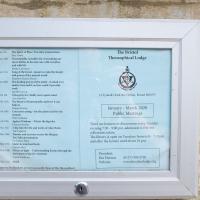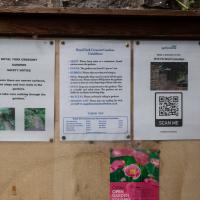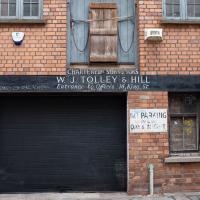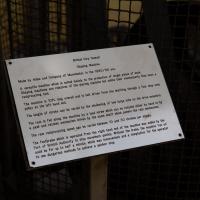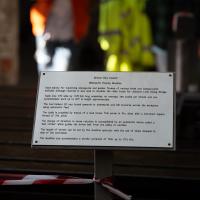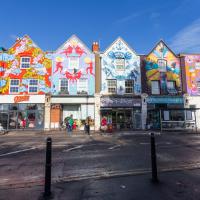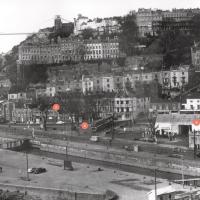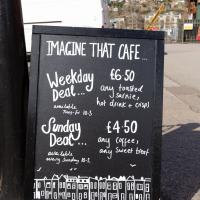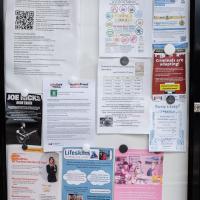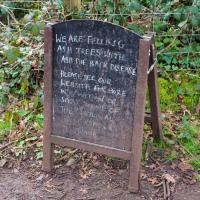Tagged: g
I managed to knock off a reasonable chunk of the roads I had left to walk around the University at the north-eastern extremity of my mile on this nice sunny walk. As well as being impressed by the number of big townhouses now occupied by various departments, I took some time on my way there to check out a war memorial, and some time on the way back to do a little extra wandering of Berkeley Square.
The Theosophical Society also lets its lodge be used by a variety of other organisations, including the Bristol Dowsers; a branch of Carlos Castaneda's Tensegrity folk (some of the videos of Tensegrity are quite something); a meditation group; and the local branch of the White Eagle Lodge, founded by a medium who received various teachings from the eponymous founder.
Given that those are the groups who openly practise there, I can only imagine the list of occult factions who use the rooms on other days...
Tags: Bristol Places UK onemilematt united kingdom Clifton Bristol Theosophical Lodge Theosophical Lodge theosophy
Auto-Tags: Rectangle Font Wood Commemorative plaque Landscape Symmetry History Memorial Public utility Circle Interior design
Text Recognition Tags: १८का Noy The Bristol Ihe Sprit at a Teabe ptia Theosophical Lodge ianer hatties becs vanale Sengtihe fesot-mt evkettee d prerd the rall Maten a Me mh Ihe bshng pewerthe id- det trdil d werk Taagrity orul adaat ind 14 Terudals Pukd. C. ri BS Y In kiry of lepale sad be January - March 2020 Public Meetings Mign e h Coesces catag -ke ptaette te Fe Ai d Wtheeg de l Acher Mad Adeiheld wel o Alke ley There are lectures or discuesionsaery Tday evening 70- 9:00 pm almisioe is te hit collectuns takem The libwary is open on Temdays Irom457m and after the lectune until about io pm. Mar un Te ed m thto Tee Tube tut Hes Oetinindan N enttigr t g kat he atda fne Prsident (OL17) 9047n5 www.beisthedodge ang Hei Hanon Webshe १८का Noy The Bristol Ihe Sprit at a Teabe ptia Theosophical Lodge ianer hatties becs vanale Sengtihe fesot-mt evkettee d prerd the rall Maten a Me mh Ihe bshng pewerthe id- det trdil d werk Taagrity orul adaat ind 14 Terudals Pukd. C. ri BS Y In kiry of lepale sad be January - March 2020 Public Meetings Mign e h Coesces catag -ke ptaette te Fe Ai d Wtheeg de l Acher Mad Adeiheld wel o Alke ley There are lectures or discuesionsaery Tday evening 70- 9:00 pm almisioe is te hit collectuns takem The libwary is open on Temdays Irom457m and after the lectune until about io pm. Mar un Te ed m thto Tee Tube tut Hes Oetinindan N enttigr t g kat he atda fne Prsident (OL17) 9047n5 www.beisthedodge ang Hei Hanon Webshe
Green Squares and Secret Gardens
31 Jul 2021
At the end of July I went to have a look around some of the private gardens opened up by the annual Green Squares and Secret Gardens event. Sadly it was compressed into a single day this year, for various Covid-related reasons, it seems, so I didn't get to poke around too many places. I went to:
- A talk by the oldest resident of Victoria Square
- The St Vincent's Rocks Hotel garden
- The Paragon garden
- Cornwallis Crescent gardens, both east and west
- The Polygon garden
And snapped a few things in between, too. It was a lovely day—a bit too hot, if anything—and it was interesting to get into a few places I'd only ever seen from the outside, especially The Paragon and Cornwallis gardens, which are the least visible to passing strangers of all of them.
Tags: Bristol Places UK onemilematt united kingdom Clifton Village Clifton Royal York Crescent Garden Clifton Open Garden Squares Green Squares and Secret Gardens open day Royal York Gardens
Auto-Tags: Leaf Wood Font Biome Poster Display board Tree Bulletin board Signage Post-it note Landscape Advertising Facade Plant Art
Text Recognition Tags: anfun Royal York Crescee Candene Gaideliees ROYAL YORK CRESCENT ET P g d wYCvG Wall Cargaign GARDENS HOUThe SAFETY NOTICE Be awe there euenurtace some steps nd tree rests in the DOOK D nd Thi adens l demidring ICYCLES.m, dng ding Peese take sare waieg thegh the MAILING LNE d KO SCAN ME Citun OPEN GARDEN SOUAREc anfun Royal York Crescee Candene Gaideliees ROYAL YORK CRESCENT ET P g d wYCvG Wall Cargaign GARDENS HOUThe SAFETY NOTICE Be awe there euenurtace some steps nd tree rests in the DOOK D nd Thi adens l demidring ICYCLES.m, dng ding Peese take sare waieg thegh the MAILING LNE d KO SCAN ME Citun OPEN GARDEN SOUAREc
A Morning of Research and a Cafe in a Castle
25 Sep 2021
I needed to pop to the library, as they'd kindly dug a book out of the reserve store at the B Bond warehouse for me and emailed me to let me know it was ready. So, I took a little trip to town, straight down the Hotwell Road, and spent a few hours reading before stretching my legs with a walk to a new cafe in the actual castle (or remnants thereof, anyway) of Castle Park, before heading back home down the other side of the harbour. As well as books and coffee, I bumped into a remote-controlled pirate ship, which isn't something you see every day, even in Bristol.
Presumably if something fails a survey they make the bulder walk the plank.
Tags: Bristol Places UK onemilematt united kingdom City Centre Little King Street W J Tolley & Hill
Auto-Tags: Property Window Wood Building Brickwork Road surface Fixture Brick Asphalt Architecture Building material Font Neighbourhood Residential area Real estate
Text Recognition Tags: CHARTENCO SunORS W. J. TOLLEY & HILL Entrange to Ofices 16, King St. G NO PARKING IN USE DAY & NIGT CHARTENCO SunORS W. J. TOLLEY & HILL Entrange to Ofices 16, King St. G NO PARKING IN USE DAY & NIGT
I'm afraid that this is a bit of a badly-curated wander, where I mostly just popped out to find out a little of the history of Underfall Yard and poke around the various open workshops, and, in hindsight, really didn't take pictures in any kind of coherent order. So there's a lot of pictures, but they don't really tell the story that, in hindsight, I seem to have been trying to tell, of the unusual electrical substation in Avon Crescent, the Bristol Electricity that predates the National Grid but is still in use, the history of the hydraulic power house... It's a bit of a mess.
But I suppose sometimes these wanders—always chronologically presented in the order I walked and took photos—simply will sometimes be a bit of a mess. Let's hope you still get something out of it, anyway...
Tags: Bristol Places UK onemilematt united kingdom Hotwells Underfall Yard Spike Island Docks Heritage Weekend
Auto-Tags: Font Material property Event Pattern Mesh Memorial Wood Signage History Commemorative plaque Metal Transport Paper
Text Recognition Tags: Bristal City Cup aping Masbina Made by Hde and Cengany of Mabeeter, the 1880/90 a A versatle acbine whih is witel nalaly te the prouction af vrge pe of w Shaping asbin ar reative of the planing maina e tr tararta Day han reelprocating toel. The naphine la tort long vera sd a halt en frem e shafting tbrg fu g puley at the ieft hand vod The langth af vtroke can be variel by thn takng of tw large wa on the drive trie The ram is fed siung the machine ty s esd sorew whiut can be rotatad wtber by hand u A pew and ratchet mechanin rlvn by the sam att w prs the rem mehastan The ram reciprocating speed an be variet tn 10 d 30 vtroke pe ita The foothrake which is operatel fron the right hand end of the saibine was t ly the Port of Bristul Autherity to stop noveent qickty. Without the trsks De sautios 'ne o codd be for uo to balf minute which wan nnint and a tengtatian for the operatar to ne dangeraun metos to adieres sker stas Bristal City Cup aping Masbina Made by Hde and Cengany of Mabeeter, the 1880/90 a A versatle acbine whih is witel nalaly te the prouction af vrge pe of w Shaping asbin ar reative of the planing maina e tr tararta Day han reelprocating toel. The naphine la tort long vera sd a halt en frem e shafting tbrg fu g puley at the ieft hand vod The langth af vtroke can be variel by thn takng of tw large wa on the drive trie The ram is fed siung the machine ty s esd sorew whiut can be rotatad wtber by hand u A pew and ratchet mechanin rlvn by the sam att w prs the rem mehastan The ram reciprocating speed an be variet tn 10 d 30 vtroke pe ita The foothrake which is operatel fron the right hand end of the saibine was t ly the Port of Bristul Autherity to stop noveent qickty. Without the trsks De sautios 'ne o codd be for uo to balf minute which wan nnint and a tengtatian for the operatar to ne dangeraun metos to adieres sker stas
Tags: Bristol Places UK onemilematt united kingdom Hotwells Underfall Yard Spike Island Docks Heritage Weekend
Auto-Tags: Font Event Room Public event Carmine Magenta Signage Audio equipment
Text Recognition Tags: B oty Dea wwerth Pa Mae Ud y fer wa g sinegate nd L ham f ri and rerent it at ty it w md to sake the tre for m L wng BriA Table wee ar we y 14tG ang te m anraga te y pw niste nd se e dte werk a to Gft ia arenates The toe ers th rael pard or d traver aro te werkl g satana te the tale prled ky e efa ad ar Thie sere s dis un A tentert spare thread of in TM shege of aetion l rretation l an ya tatie ve calada t striker w the iv at freN e er to anather The lengn uf str et ty the a wster w ihe se of sto pd t f the vrktak The s odataastre veriates of 10 e k B oty Dea wwerth Pa Mae Ud y fer wa g sinegate nd L ham f ri and rerent it at ty it w md to sake the tre for m L wng BriA Table wee ar we y 14tG ang te m anraga te y pw niste nd se e dte werk a to Gft ia arenates The toe ers th rael pard or d traver aro te werkl g satana te the tale prled ky e efa ad ar Thie sere s dis un A tentert spare thread of in TM shege of aetion l rretation l an ya tatie ve calada t striker w the iv at freN e er to anather The lengn uf str et ty the a wster w ihe se of sto pd t f the vrktak The s odataastre veriates of 10 e k
Ticking Off a Few Streets in Bedminster
31 Oct 2021
There were only a few streets left to wander in the more residential bit of Bedminster, so I thought I should target those today. The streets themselves weren't that notable, though Balfour Road has a contrasting mix of old and new housing. I tried to snap a few more interesting things along the way there and back, snapping all three of the familiar bond warehouses, nipping onto North Street to find some new street art, and finding a few pumpkins for good measure. It is hallowe'en, after all...
Trying a new angle with my new wide lens, but even that can barely fit them in square-on. Plus I could do with a higher sun to avoid the shadows, tricky to come by at this time of year.
Tags: Bristol Places UK onemilematt united kingdom Bedminster graffiti street art
Auto-Tags: Sky Window Building Cloud Neighbourhood Public space Residential area Leisure Facade City Plant Recreation Road Travel Urban area
Text Recognition Tags: barons peperty :oontre Peter Burrows G Co. barons peperty :oontre Peter Burrows G Co.
I went out simply wanting to knock off the very last little unwalked section of Clanage Road, over by Bower Ashton, which has been annoying me for a while as it's quite close by and I've walked the other bits of it several times. So, my plan was to nip over to Greville Smyth Park via a slightly unusual route to wander Clanage Road and tick it off.
Along the way, though, I inevitably got a bit distracted. I took a few photos of Stork House, a grand Hotwell Road building that's recently been done up a bit (I imagine it's student lets, though I'm not sure) and which I found a reference to in a book about the Port Railway and Pier the other week, and also tried to match up a historical photo of Hotwells before the Cumberland Basin Flyover System laid it waste, which included some interesting markers I'll have to do a bit more digging into...
I found this image on Pinterest and as usual for that site it was annoyingly uncredited, but it seems to be from the book Hotwells, Spa to Pantomime, which I've just ordered direct from Bristol Books. Hopefully I'll be able to update the credit a bit when it arrives.
There's quite a lot in here that I didn't know about and will be researching a bit more, especially the Spa Assembly Rooms, which I think later turned into a school before being demolished for the flyover system, and also Anderson's workshop, a last vestige of the figurehead-carving industry.
Tags: Bristol Places UK onemilematt united kingdom Hotwells Cumberland Basin Flyover System Brunel's Other Bridge Terrett Memorial Hall assembly rooms Anderon's Workshop Brethren Chapel Rownham Inn Sopey Park
Auto-Tags: Building Infrastructure Sky Neighbourhood Landscape Monochrome Residential area City Monochrome photography House Urban area Window History Road Urban design
Text Recognition Tags: orweus r wesCI BAA Maryof g hetowanolhed tan O a O he Cup And r Te Mee H O S Assenty ee Orels Harived orweus r wesCI BAA Maryof g hetowanolhed tan O a O he Cup And r Te Mee H O S Assenty ee Orels Harived
In Which We Begin and End with Love
05 Mar 2022
I had a lot to get done around the house, so as soon as I heard there might be a shiny new piece of street art near me, under the Cumberland Basin flyovers, I immediately decided that was all the excuse I needed to set off on a round-the-harbour lunchtime walk to get some fresh air and see if I could spot it. So, here's a circular wander that takes in graffiti, boats, wildlife and graffiti again...
Tags: Bristol Places UK onemilematt united kingdom cafesigns floating harbour Spike Island Imagine That marina Bristol Marina harborside
Auto-Tags: Motor vehicle Handwriting Sky Cloud Font Plant Public space Gas Road surface Signage City Tree Asphalt Grass Advertising
Text Recognition Tags: MAGINE THAT CAFE. €6 50 Weekday Deal. any toasted ... hot drink + cisps ami lable Tuag-fri 10-3 Sunday £450 £4 50 Deal.. any Cafee. any Sweet treat ava lable every Sunday 10-2 回G 06E000m日 MAGINE THAT CAFE. €6 50 Weekday Deal. any toasted ... hot drink + cisps ami lable Tuag-fri 10-3 Sunday £450 £4 50 Deal.. any Cafee. any Sweet treat ava lable every Sunday 10-2 回 G 06E000m 日
Nipping Up the Zig Zag to the Shops
19 Aug 2023
It's been a long while since I did one of these walks.
I'm thinking of finishing up the project by walking one or two last bits of road, thus being able to declare with all honesty that I've done my best to walk every public road within my mile (and quite a few alleyways besides.) As a prelude, and just because I felt like it, I decided to drag out the camera and GPS on this little wander to the local shops.
Also looking nice and fresh since my last wander is the pair of community noticeboards, with a plethora of local news.
I found out recently that I was a winnner of one of the Hotwells & Cliftonwood Community Association 500 club prizes, which, alongside my membership, is a fun way to give money to the local organisation that puts up these noticeboards and does so much else for the community.
Tags: Bristol Places UK onemilematt united kingdom Clifton Village Hotwells Clifton
Auto-Tags: Poster Font Advertising Picture frame Signage Display board Event Wood Facade Publication Transport Landscape Banner Art
Text Recognition Tags: Howells and Cliftonwood Community Association (ACCA) community cond Useful local information Cond Local Pang Vefa Avon and R Ay GTA abyQMalaw De Oy He PO De 30 G F PAD Lesson for t FRA Obag w BATANGA to your whatapang Var JOE MICKS GUITAR TEACHER BUTHORE.COM y Gramgenee07504 ty PO Box 200 Online Coaching and 61100 TW utrition Quidance Fra ersonal Training sessions LONDRE om prope tech y and get aang d 222000 Get Fit, Be Healthier, Be The Best Version Of You! www.top be and reach SOF ing out to Our sto Quran We have ww Facebook Tutir @COtt G35 Top for my on or stop you A O 07564375433 @w tabourside and Satu Action Fraud ALERT AF Google .***. of St DAS y Th y AudionFraud SA 13304 W 15. Ch Lifeskitts LEARNING FOR LIVING Guing which includes working wilt amal and active safatyti Wysan bes the fe WELCOME SPACE at CLIFTON LIBRARY activitating January 2635 (10 ng WELCOME SPACE We are currently looking for people to help us deliver safety education to children via our enginteractive village based in central Bristol www50 Hotwells & Cliftonwood Community Association 500 CLUB RESULTS 2023 1 mn m Hot drinks Relax GAMES CRAFTING Films CHAT Wellbeing Newspapers Study KAPHY TABLE TENNIS Hasting which includes opening and sing talk with the c sporting teachers re The 100 Challe Join us for a tester heut Wednesday 12th April is the next scheduled taster hour please contact the email below for more information and to book your place OLLYW4 Hvat e ang pag Apt Now swight Robert C con Nowhe CIP ad NC Nowe Man No for 2 yr y dece ww OXO AUTY New THANK YOU TO ALL OF THE YOUR 300C SUCTIONS A HANG POSLE POES THAT HELPO THE LOCALE EVERY MONTH WE HAVE UNCLAIMED PRIZE HONEY THAT COULD YOUR CLUB FOR THE CHANCE TO BE YOU NAM NAD OF NO WINNER OWN AND SUPPORT THE WORK OF YOUR LOCAL COMMUNITY SCAN ME bile PR COURE Ap C Te qu 700 Emetas T Com You to t You fost d Shpaloaph we would love to make oef regularly vegade ba ne Beinart Art & Art haling p A you missing making an DEMENTIA SAFEGUARDING SCHEMEL www.beinartotive.c 4 Ben sad fin BEWARE PROSITY Criminals are adapting! there are many where you ca weket M -Tudo que fa thoshwade - pada poleg oniks and li MA ART whick - server creaty PCRIME and the deving the vers If you're not sure, research more! www Having a baby? - PRACTICAL and EMOTIONAL support is available for you in the cala in pomancy, birth and pomnically Sear Roma Helen Whit ANME PROCITY O Howells and Cliftonwood Community Association ( ACCA ) community cond Useful local information Cond Local Pang Vefa Avon and R Ay GTA abyQMalaw De Oy He PO De 30 G F PAD Lesson for t FRA Obag w BATANGA to your whatapang Var JOE MICKS GUITAR TEACHER BUTHORE.COM y Gramgenee07504 ty PO Box 200 Online Coaching and 61100 TW utrition Quidance Fra ersonal Training sessions LONDRE om prope tech y and get aang d 222000 Get Fit , Be Healthier , Be The Best Version Of You ! www.top be and reach SOF ing out to Our sto Quran We have ww Facebook Tutir @COtt G35 Top for my on or stop you A O 07564375433 @w tabourside and Satu Action Fraud ALERT AF Google . *** . of St DAS y Th y AudionFraud SA 13304 W 15. Ch Lifeskitts LEARNING FOR LIVING Guing which includes working wilt amal and active safatyti Wysan bes the fe WELCOME SPACE at CLIFTON LIBRARY activitating January 2635 ( 10 ng WELCOME SPACE We are currently looking for people to help us deliver safety education to children via our enginteractive village based in central Bristol www50 Hotwells & Cliftonwood Community Association 500 CLUB RESULTS 2023 1 mn m Hot drinks Relax GAMES CRAFTING Films CHAT Wellbeing Newspapers Study KAPHY TABLE TENNIS Hasting which includes opening and sing talk with the c sporting teachers re The 100 Challe Join us for a tester heut Wednesday 12th April is the next scheduled taster hour please contact the email below for more information and to book your place OLLYW4 Hvat e ang pag Apt Now swight Robert C con Nowhe CIP ad NC Nowe Man No for 2 yr y dece ww OXO AUTY New THANK YOU TO ALL OF THE YOUR 300C SUCTIONS A HANG POSLE POES THAT HELPO THE LOCALE EVERY MONTH WE HAVE UNCLAIMED PRIZE HONEY THAT COULD YOUR CLUB FOR THE CHANCE TO BE YOU NAM NAD OF NO WINNER OWN AND SUPPORT THE WORK OF YOUR LOCAL COMMUNITY SCAN ME bile PR COURE Ap C Te qu 700 Emetas T Com You to t You fost d Shpaloaph we would love to make oef regularly vegade ba ne Beinart Art & Art haling p A you missing making an DEMENTIA SAFEGUARDING SCHEMEL www.beinartotive.c 4 Ben sad fin BEWARE PROSITY Criminals are adapting ! there are many where you ca weket M -Tudo que fa thoshwade - pada poleg oniks and li MA ART whick - server creaty PCRIME and the deving the vers If you're not sure , research more ! www Having a baby ? - PRACTICAL and EMOTIONAL support is available for you in the cala in pomancy , birth and pomnically Sear Roma Helen Whit ANME PROCITY O
Leigh Woods Walk
14 Mar 2021
An enormous walk today, or at least it felt enormous. My feet are sore, anyway. I started off recreating a couple of local historical photos in Hotwells, but then headed for my traditional walk along the towpath in the Avon Gorge to the far extreme of Leigh Woods, up and through the woods to the height of the Suspension Bridge, finally crossing into Clifton Village for a well-deserved vanilla latte.
I say "traditional" because this used to be a very regular route for me, first walking, years and years ago, and later jogging—this route combined with a circuit of the Downs on the other side used to be my way of making sure I was fit to do a half-marathon (I did six of them in total, between 2010 and 2014).
I miss the routine of this walk, even though it's a long way and it used to pretty much wipe me out when I did it—I'd come back home and collapse and do very little for the rest of the day. But perhaps that's what Sundays are for, and I should try to remember that.
Doing this walk regularly was quite a meditative experience. Not so much of that today, but once I got to the further extreme of the towpath, where the roar of the Portway traffic on the other side of the river dwindles and I turned into Leigh Woods to climb ever closer to birdsong and further from rushing cars, I did seem to recapture a little of the feeling of previous walks. (I would say my mind cleared, but I was mentally singing along to Life Without Buildings' The Leanover for most of the wander. There are worse songs to have stuck in one's head, though; it's a great track...)
Anyway. Apparently the walk made me more likely to ramble in words, too. I'll stop now :)
More details here
Ash dieback is caused by a fungus that originated in Asia. It doesn’t affect ash trees native to the region, but has had a devastating effect on European ash, which is found in the UK.
The fungus produces small fruiting bodies between July and October. The spores can blow many miles away, which is what makes it so difficult to control. Once it’s landed, the fungus grows inside the tree and blocks its water systems, causing the tree to die.
Tags: Bristol Places UK onemilematt united kingdom Leigh Woods forest woods
Auto-Tags: Plant Plant community Wood Grass Natural landscape Tree Trunk Groundcover Forest Font Landscape Commemorative plaque Signage Woodland Number
Text Recognition Tags: WE ARE FELLINS G ASH TREES WITI ASH DIE BACK NSEASE PLEASE SEE OUR HEBSITE. FeR HORE WE ARE FELLINS G ASH TREES WITI ASH DIE BACK NSEASE PLEASE SEE OUR HEBSITE. FeR HORE
